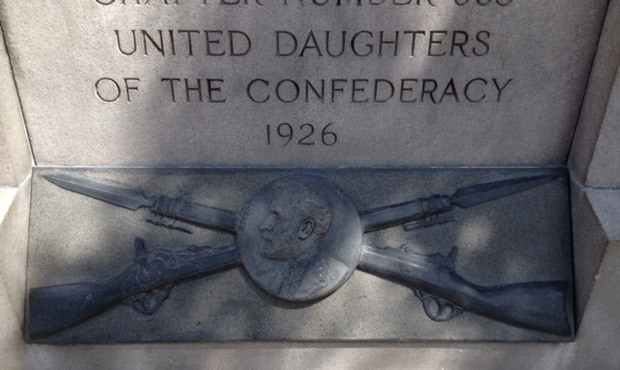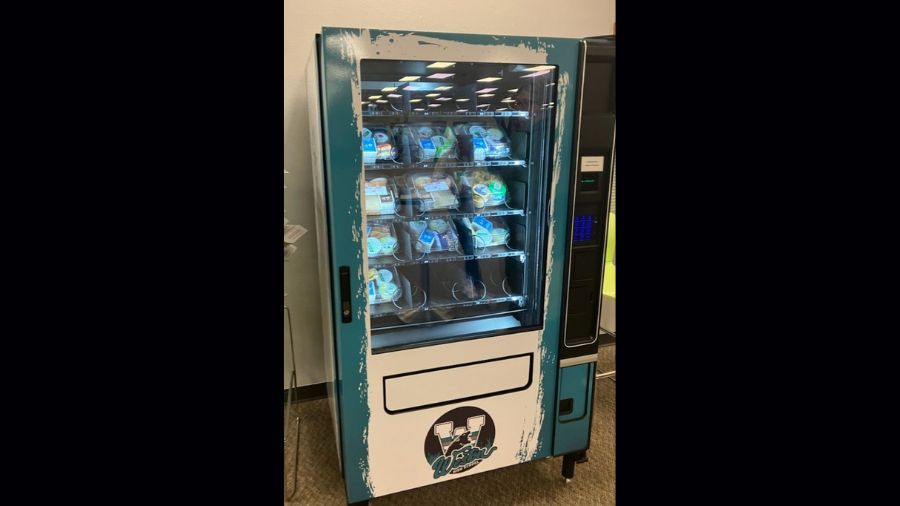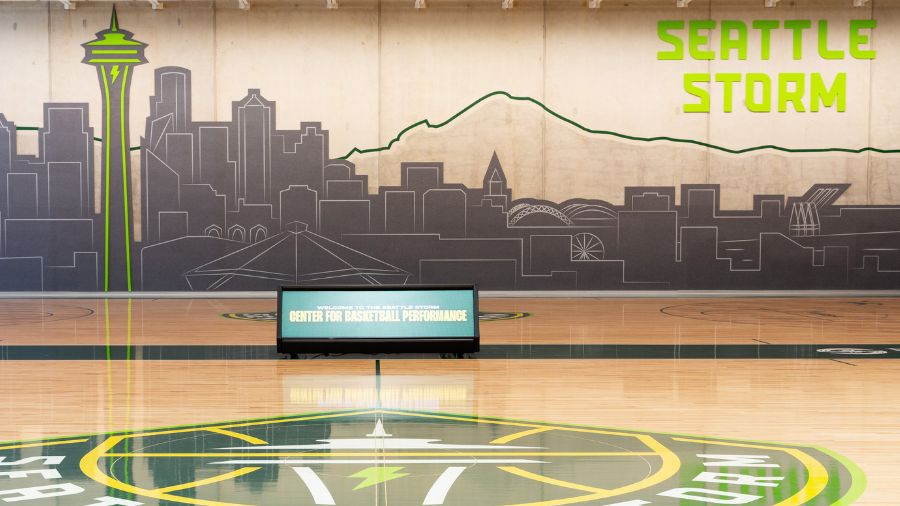Why there are so many Confederate monuments in Seattle
Jul 15, 2015, 9:08 AM | Updated: 11:13 am

Seattle historian Feliks Banel says it's no surprise that as Confederate veterans who lived in Washington were passing away, organizations such as the Daughters of the Confederacy sought to honor their ancestors with monuments such as the controversial one at Lake View Cemetery. (MyNorthwest/Richard D. Oxley)
(MyNorthwest/Richard D. Oxley)
“There have been found within the Department persons so utterly infamous as to exult over the assassination of the president. Such persons become virtually accessories after the fact and will at once be arrested.”
These harsh words are from an order issued by the U.S. Army in San Francisco to soldiers on the West Coast a few days after President Abraham Lincoln was assassinated in April 1865. They’re a reminder that though we were thousands of miles from the battlefields of the Civil War, the political debates about slavery and secession were front and center, even in the Pacific Northwest.
There’s been a lot of talk and debate lately about history and the power of symbols such as the Confederate flag or Confederate war memorials, but it’s mostly forgotten these days what role slavery played in the Pacific Northwest and about what happened here during the Civil War era.
While we don’t have a flag that readily symbolizes it, some of our predecessors (and, for some of us, some of our ancestors) here in the Pacific Northwest condoned or did not oppose slavery in the South, and even worked to allow it here; voted to exclude free blacks from settling in Oregon; supported the Confederacy in the Civil War, and in some cases went to fight for the Confederacy against the United States; and, as noted above, celebrated when President Lincoln was assassinated.
Back in the 1840s, the term “Oregon Country” was used to describe what mostly comprises present-day Washington, Oregon, and Idaho. The non-Native population was small then, but was growing rapidly thanks to overland migration on the Oregon Trail. And the population here was a pretty decent cross-section of America, with migrants from all over the United States reflecting a fairly accurate political microcosm of the United States at that time (though overwhelmingly male and pretty young by comparison). So there were people here who supported the idea of slavery and people who opposed it — just like most of the United States in those years.
There are several moments worth revisiting to better understand the complexity of the political situation in the Pacific Northwest and how distant political causes influenced people here. The debate about slavery was heated at times, but it was also mostly theoretical, as the African American population in the Northwest then was very small.
Provisional government prohibits slavery
In 1843, while the Oregon Country was still jointly occupied and claimed by the British and the United States, residents here created a provisional government at a meeting held in Champoeg (a community on the Willamette River south of what’s now Portland). Slavery was excluded as per the Ordinance of 1787 – the legislation that created the Old Northwest Territories (the first “new” territories after the American Revolution).
Creation of Oregon Territory delayed by the slavery issue
The U.S. and Great Britain settled their joint claims to the Oregon Country in 1846 and established the U.S. border at the 49th parallel. But formal creation of Oregon as an official territory of the United States was delayed for two years by the debate in Congress over whether Oregon would be a free territory or a territory that permitted slavery. When Oregon Territory was finally created in August 1848 by a narrow vote in the Senate, slavery was implicitly barred. Senator Andrew Butler of South Carolina said that the bill creating Oregon Territory was, “a masked battery, from behind which the institutions of the south were to be assailed with a firm determination to subdue them.”
Oregon votes to prohibit slavery … and blacks in general
By the late 1850s, Oregon was moving to become a state, and had to create a state constitution. Territorial lawmakers let the people decide on a couple of key issues regarding African Americans. The good news is that Oregonians voted to exclude slavery from Oregon by a final count of 7,727 to 2,645. The bad news is that Oregonians also voted to prohibit any African Americans from settling in Oregon, period, by a final count of 8,640 to 1,081. The reasons people wanted to exclude blacks then were many — fears of economic problems that slavery might create, fears that the mixing of whites with an “inferior” race would ultimately lead to societal calamity. Meanwhile, some pro-slavery Oregonians reasoned that slaves were just what the local economy needed and that slaves would have an easier life in the Pacific Northwest, where agriculture practices such as plantings and harvests were less intense than in the American South.
Washington Territory’s Governor Gholson owned slaves
In 1859, Washington Territorial Governor Richard Gholson was a Southern Democrat from Kentucky who’d been appointed by President Buchanan (Lincoln’s predecessor). In his December 1859 message to the Washington Territorial Legislature, Governor Gholson warned of the troubles ahead and said, “Let us in this embryo state beware of the hydra-headed monster dissolution” and let’s remain devoted to the Union and the Constitution — which, in Gholson and other Southern Democratic minds, meant allowing slavery here. Gholson left Washington Territory in May 1860 and headed back to Kentucky, where he owned slaves, because of the looming secession crisis. Then, right before Lincoln was sworn in as president in early 1861, Gholson resigned and said that he was, “unwilling, even for a day, to hold office under a Republican president”
The Knights of the Golden Circle
During the Civil War era, there was a militant group organized near Olympia called the Knights of the Golden Circle. Throughout the Civil War, they drilled with weapons, swore an oath to kill Lincoln appointees and fomented a “Pacific Confederacy” along the West Coast. They were rumored to have chapters all over the Northwest, but that may have been just that: only rumors.
Washington Territory’s first governor died a Union Army hero
Washington Territory’s first governor was Isaac Stevens, who was a fairly complex character. Stevens was a Northern Democrat from Massachusetts who was appointed to lead Washington Territory by President Pierce in 1853. Stevens had been first in his class at West Point, and after serving as Territorial Governor, was elected by voters in Washington Territory to serve as Territorial Delegate, representing us in Congress. As the Civil War broke out, he headed back East, joined the Union Army and then died a hero in 1862 at the Battle of Chantilly.
Possible reason for so many monuments in the Pacific Northwest
The period after the Civil War ended was a time of major migration west for Americans. Thousands of men who came to the Pacific Northwest had fought in the Civil War, some for the Union, some for the Confederacy. As those aged veterans began to die in great numbers in the late 19th century, people of the Northwest were also beginning to pause, catch their collective breath after a very busy period of settlement and growth, and look back at their history. It’s no coincidence that the Washington State Historical Society was founded in this era of reflection (in 1891), and that the first exhaustive written history of Washington was published by Hubert Howe Bancroft a year earlier. That same historical society went on something of monument frenzy in the early 20th century, dedicating obelisks and tablets to mark visits by explorers, Indian battles, and political milestones. So it’s no surprise that as Confederate veterans who lived here were also passing away, organizations such as the Daughters of the Confederacy also sought to honor their ancestors with monuments such as the controversial one at Lake View Cemetery in 1926; the tree dedicated to Confederate General Robert E. Lee at Seattle’s Ravenna Park in 1909; or the special “Dixie Day” at the 1909 Alaska-Yukon-Pacific Exposition world’s fair held on the University of Washington campus. Union veterans and their descendants did the same thing, and the best example of this is the Grand Army of the Republic cemetery founded on Capitol Hill in the 1890s.
The takeaway from all of this is that we must never deny any part of our history. We must embrace all of it, even the unpleasant parts (especially the unpleasant parts: slavery, Japanese-American internment, racism, treatment of Native Americans, Anti-Chinese riots, shootings of striking workers, and so on), and use our history as a tool to understand the present and to better prepare for the future.
Is there a monument from our past that you find offensive? Take a middle schooler there and explain to her why it was put there in the first place and by who. Then explain why you find it offensive. Ask her what she thinks and why. The cure for coming to terms with the unpleasant aspects of our history has three ingredients: context, context, and context.













